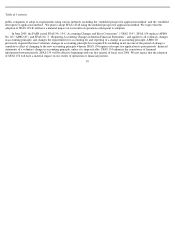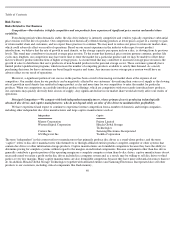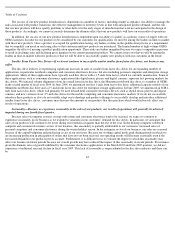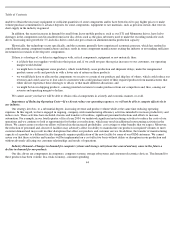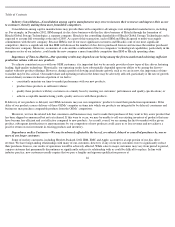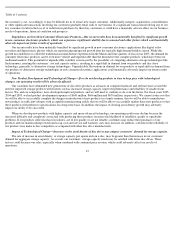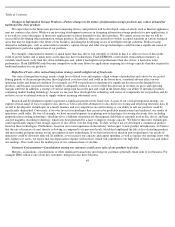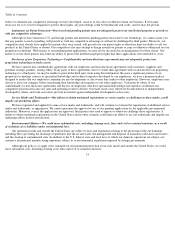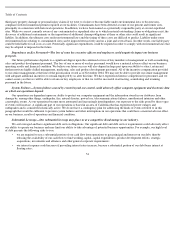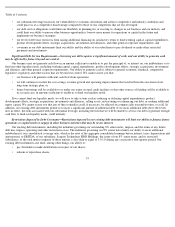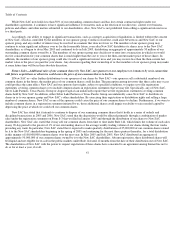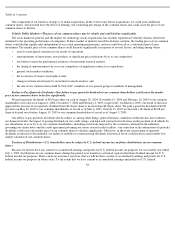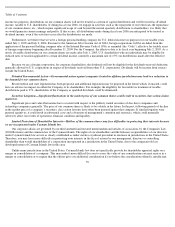Seagate 2004 Annual Report Download - page 52
Download and view the complete annual report
Please find page 52 of the 2004 Seagate annual report below. You can navigate through the pages in the report by either clicking on the pages listed below, or by using the keyword search tool below to find specific information within the annual report.
Table of Contents
with the disc drive business of Hitachi through the formation of a new company with which IBM has entered into a multi-year supply
agreement. As a result, IBM may decrease its purchases from us in favor of this new company. If a significant transaction involving any of our
key customers results in the loss of or reduction in purchases by these key customers, it could have a materially adverse effect on our business,
results of operations, financial condition and prospects.
OEM Purchase Agreements—Our OEM customers are not obligated to purchase our products.
Typically, our OEM purchase agreements permit OEMs to cancel orders and reschedule delivery dates without significant penalties. In
the past, orders from many of our OEMs were cancelled and delivery schedules were delayed as a result of changes in the requirements of the
OEMs’ customers. These order cancellations and delays in delivery schedules have had a material adverse effect on our results of operations in
the past and may do so again in the future. Our OEMs and distributors typically furnish us with non-binding indications of their near term
requirements, with product deliveries based on weekly confirmations. If actual orders from distributors and OEMs decrease from their non-
binding forecasts, these variances could have a material adverse effect on our business, results of operations, financial condition and prospects.
Economic Risks Associated with International Operations—Our international operations subject us to risks related to currency
exchange fluctuations, longer payment cycles for sales in foreign countries, seasonality and disruptions in foreign markets, tariffs and
duties, price controls, potential adverse tax consequences, increased costs, our customers’ credit and access to capital and health-related
risks.
We have significant operations in foreign countries, including manufacturing facilities, sales personnel and customer support operations.
We have manufacturing facilities in China, Malaysia, Northern Ireland, Singapore and Thailand, in addition to those in the United States. A
substantial portion of our desktop disc drive assembly occurs in our facility in China.
Our international operations are subject to economic risks inherent in doing business in foreign countries, including the following:
•
Disruptions in Foreign Markets
. Disruptions in financial markets and the deterioration of the underlying economic conditions in
the past in some countries, including those in Asia, have had an impact on our sales to customers located in, or whose end-user
customers are located in, these countries.
•
Fluctuations in Currency Exchange Rates
. Prices for our products are denominated predominately in U.S. dollars, even when sold
to customers that are located outside the United States. Currency instability in Asia and other geographic markets may make our
products more expensive than products sold by other manufacturers that are priced in the local currency. Moreover, many of the costs
associated with our operations located outside the United States are denominated in local currencies. As a consequence, the increased
strength of local currencies against the U.S. dollar in countries where we have foreign operations would result in higher effective
operating costs and, potentially, reduced earnings. From time to time, fluctuations in foreign exchange rates have negatively affected
our operations and profitability and there can be no assurance that these fluctuations will not adversely affect our operations and
profitability in the future.
•
Longer Payment Cycles
. Our customers outside of the United States are often allowed longer time periods for payment than our
U.S. customers. This increases the risk of nonpayment due to the possibility that the financial condition of particular customers may
worsen during the course of the payment period.
•
Seasonality . Seasonal reductions in the business activities of our customers during the summer months, particularly in Europe,
typically result in lower earnings during those periods.
49
•
Tariffs, Duties, Limitations on Trade and Price Controls . Our international operations are affected by limitations on imports,
currency exchange control regulations, transfer pricing regulations, price


